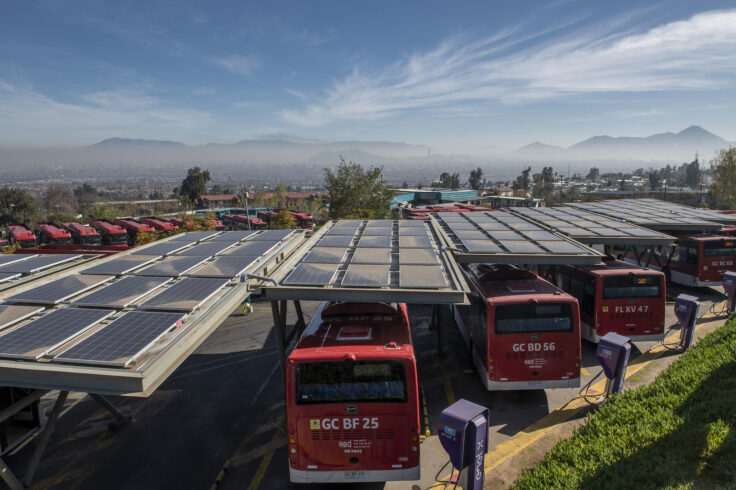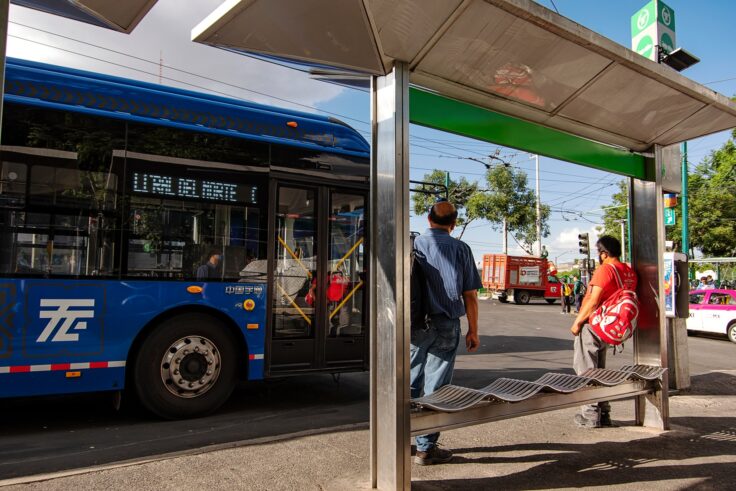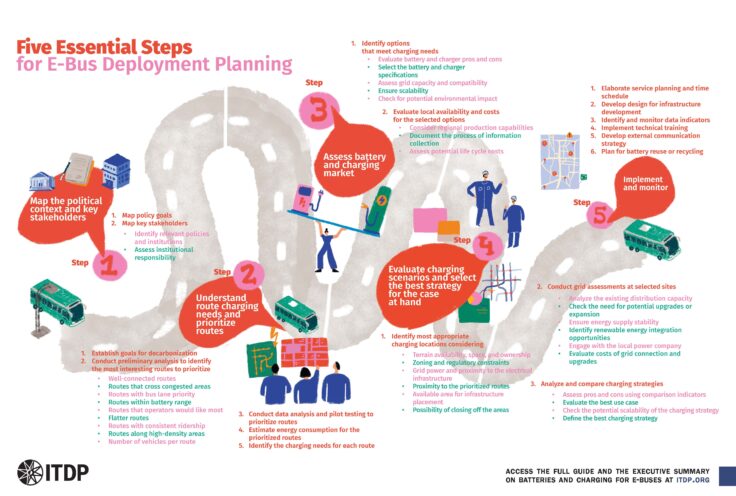February 17, 2025
For E-Buses to Succeed, Cities Need to Focus on Charging and Implementation
The electrification of public transport has emerged as a crucial step in advancing environmental sustainability, improving air quality, and enhancing urban mobility.
Access ITDP’s full “Advancing E-Buses” Guide here.
Cities worldwide are integrating e-buses into their public transport systems, marking significant progress towards decarbonization and improving passenger experience. However, this transition involves more than merely replacing traditional vehicles with electric ones — it requires a strategic focus on charging infrastructure, grid capacity, and operational planning to ensure long-term success. Globally, the challenges of e-bus implementation often arise from prioritizing vehicle procurement over charging infrastructure development. With an effective charging plan, one e-bus can typically replace a diesel bus on most routes. However, without a plan, one diesel bus might need two e-buses to operate the same service, dramatically increasing costs.
An early example of this challenge was during initial bus electrification efforts in China, where national subsidies initially focused on e-bus purchases. To ensure scalability, China’s government later extended these incentives to include charging infrastructure, enhancing the efficiency of e-bus deployment nationwide. Similarly, India’s Faster Adoption and Manufacturing of Electric Vehicles (FAME) I scheme, while successful in supporting early e-bus adoption, lacked sufficient guidance on charging needs and infrastructure. This shortfall prompted the government to adopt a more holistic approach in FAME II and the country’s subsequent PM e-Bus Sewa Scheme, which surpassed FAME I in facilitating e-bus adoption and operation in hundreds of Indian cities. These experiences highlight the critical need to integrate vehicle procurement with infrastructure planning for effective e-bus deployment.

In other major cities like São Paulo and Curitiba in Brazil, recent operational analysis of e-bus pilots conducted under various conditions revealed significant variability in energy consumption, even when using the same battery model and charging setup. Factors such as route profiles, weather conditions, topography, and driver behavior (e.g., maintaining consistent travel speeds) were found to directly impact energy efficiency and, consequently, overall costs. Similar studies in cities in Indonesia and Mexico yielded comparable results, highlighting the critical impacts of batteries, chargers and grid interdependencies on overall results.
For instance, higher energy consumption during peak-hour charging significantly increased operational expenses, potentially making e-buses more expensive in terms of total cost of ownership compared to diesel buses, offsetting their expected advantages in lower operating and maintenance costs. These findings highlight the importance of tailoring battery, charger, and charging strategies to local conditions and understanding their interconnection to optimize e-bus deployment and unlock the full economic and environmental benefits of electrification. Globally, comprehensive planning is increasingly recognized as a cornerstone for the successful transition to e-bus systems.

Comprehensive Planning is the Foundation for Success
ITDP’s recently released Advancing E-Buses: Batteries and Charging Guide highlights the importance of integrating vehicle electrification with infrastructure planning. The Guide provides a detailed framework for making informed decisions about battery technologies, charging strategies, and fleet management. By outlining international best practices and actionable recommendations, the Guide aims to support more cost-efficient and seamless transitions to e-bus fleets worldwide. Drawing on ITDP’s decades of public transport and bus expertise, this Guide seeks to leverage the consistent growth in the e-bus market to help cities make more strategic decisions. Divided into three sections, we offer actionable insights into:
- Battery Technologies – An overview of battery types, their lifecycle, and how battery size relates to charging methods.
- Charging Strategies – A deep dive into charging options, infrastructure planning, and their impact on grid capacity and costs.
- Decision-Making Framework – Practical tools to assess quality, efficiency, equity, and economic factors, supporting informed planning.
Five Steps to Successful Electrification
Most notably, the Guide outlines five essential steps to equip the decision-makers with knowledge and tools necessary to make informed, strategic decisions that support the successful decarbonization of their bus fleets:
- Map the Political Context and Stakeholders – Identify key actors and policy goals to build a cohesive implementation framework.
- Understand Route Charging Needs – Analyze route performance, city goals, and prioritize routes based on feasibility and impact.
- Assess Battery and Charger Markets – Evaluate technologies to ensure compatibility with operational and grid requirements.
- Define a Charging Strategy – Develop an infrastructure plan tailored to the needs of prioritized routes.
- Implement and Monitor – Establish systems for ongoing evaluation and adaptation to improve outcomes.
By following this structured approach, cities can avoid common pitfalls, such as grid compatibility issues and inadequate charging infrastructure.
Supporting a Future of Electric Mobility
Electrification is not merely a technological upgrade—it redefines how cities approach sustainable transport. E-buses can deliver cleaner air, reduced emissions, and lower operational costs, but these benefits depend on cross-sector collaboration and strategic planning. To keep global warming below 1.5°C, cities must pair vehicle electrification with compact urban designs that prioritize walking, cycling, and public transport. Together, these strategies can reduce car dependency, minimize emissions, and create inclusive, climate-resilient cities. The Advancing E-Buses Guide is a critical resource for cities ready to embrace electrification, helping them achieve their climate, health, and equity goals while building resilient public transport systems that meet the demands of a sustainable future.
Stay tuned for more resources on e-buses and public transport from ITDP by subscribing to the Sustainable Transport Bulletin.

